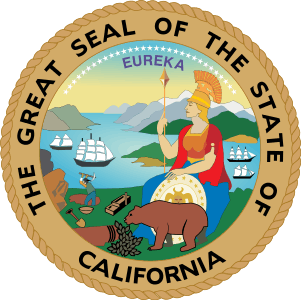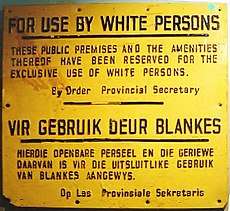California Proposition 14 (1964)
| Elections in California | ||||||||||
|---|---|---|---|---|---|---|---|---|---|---|
 | ||||||||||
|
||||||||||
|
||||||||||
|
||||||||||
| Part of a series of articles on |
| Racial segregation |
|---|
 |
| Germany |
| South Africa |
| United States |
California Proposition 14 was a November 1964 ballot proposition that amended the California state constitution, nullifying the Rumford Fair Housing Act.[1] Proposition 14 was declared unconstitutional by the California Supreme Court in 1966.[2] The decision of the California Supreme Court was affirmed by the U.S. Supreme Court in 1967 in Reitman v. Mulkey.[3]
Political science research has tied white support for Proposition 14 to "racial threat theory", which holds that an increase in the racial minority population triggers a fearful and discriminatory response by the dominating racial majority.[4]
Rumford Fair Housing Act
The Rumford Fair Housing Act was passed in 1963 by the California Legislature to help end racial discrimination by property owners and landlords who refused to rent or sell their property to "colored" people.[5] It was drafted by William Byron Rumford, the first African American from Northern California to serve in the legislature. The Act provided that landlords could not deny people housing because of ethnicity, religion, sex, marital status, physical handicap, or familial status.[6]
Proposition 14
In 1964, the California Real Estate Association sponsored an initiative to counteract the effects of the Act.[7]
The initiative, numbered Proposition 14 when it was certified for the ballot, was to add an amendment (Cal. Const. art. I, § 26) to the constitution of California. This amendment would provide, in part, as follows:
Neither the State nor any subdivision or agency thereof shall deny, limit or abridge, directly or indirectly, the right of any person, who is willing or desires to sell, lease or rent any part or all of his real property, to decline to sell, lease or rent such property to such person or persons as he, in his absolute discretion, chooses.[8]
The amendment attempted to re-legalize discrimination by landlords and property owners.
Endorsements
Following much publicity the proposition gained the endorsement of many large conservative political groups, including the John Birch Society and the California Republican Assembly. As these and other groups endorsed the proposal it became increasingly more popular and the petition to have the proposition added to the ballot garnered over one million signatures. This was more than twice the 480,000 signatures that were required.[9]
Los Angeles Times Endorsement
In endorsing Proposition 14, the Los Angeles Times stated: “One of man’s most ancient rights in a free society is the privilege of using and disposing of his private property in whatever manner he deems appropriate.” The editorial further stated: “But we do feel, and strongly, that housing equality cannot safely be achieved at the expense of still another basic right.”[10][11][12]
In a letter to the editor response to the Los Angeles Times endorsing the Proposition 14 constitutional amendment, then California Attorney General Stanley Mosk stated: “I oppose the segregation initiative. I oppose it because it sugar-coats bigotry with an appeal to generalities we can accept, while ignoring the specific problem that confronts us.”[13]
Heated campaign
The Proposition 14 campaign was heated and included several controversial comments from Edmund Brown who was the Governor of California at the time. Governor Brown stated that passage of Proposition 14 would put into California’s Constitution “a provision for discrimination of which not even Mississippi or Alabama can boast.”[14] Previously, Governor Brown had likened the campaign for Proposition 14 to “another hate binge which began more than 30 years ago in a Munich beer hall.”[15] In a letter to the editor response to several items published in the Los Angeles Times relating to Proposition 14, Governor Brown wrote: “I submit that it is not the Governor who is inflammatory. It is Proposition 14. And I submit that it is not the opponents of Proposition 14 who encourage the racists and bigots in this state, but those who support Proposition 14.”[16]
Election Results
Proposition 14 appeared on the November 3, 1964 General Election ballot in California. The ballot proposition easily passed with 65.39% support, receiving 4,526,460 votes in support and 2,395,747 votes against.[17]
Notable counties voting in favor of Proposition 14 included: Alameda County (60.6% support), Contra Costa County (64.6% support), Los Angeles County (67.4% support), Marin County (52.2% support), Sacramento County (61.6% support), San Francisco County (52.9% support), San Mateo County (60.2% support), Santa Clara County (53.1% support), Santa Cruz County (58.5% support), Solano County (69.7% support), Sonoma County (61.8% support), and Yolo County (56.4% support).[18]
Notable cities voting in favor of Proposition 14 included: Alameda, Oakland, Richmond, Fresno, Inglewood, Long Beach, Los Angeles, Lynwood, Pasadena, Santa Monica, Salinas, Santa Ana, Palm Springs, Riverside, Sacramento, San Bernardino, San Francisco, San Mateo, Santa Barbara, San Jose, Santa Clara, Santa Cruz, Vallejo, Santa Rosa, Modesto, Oxnard, and Ventura.[19]
A 2018 study in the American Political Science Review found that white voters in areas which experienced massive African-American population growth between 1940 and 1960 were more likely to vote for Proposition 14. Political scientists have taken this as evidence for "racial threat theory", which holds that the rapid increase in a minority population triggers fears among the majority race population, leading the majority to impose higher levels of social control on the subordinate race.[4]
Unconstitutionality
Soon after it was passed, the federal government cut off all housing funds to California. Many also cited the proposition as one of the causes of the Watts Riots of 1965.[20]
With the federal housing funds cut off and with the support of Governor Pat Brown, the constitutionality of the measure was challenged soon afterward. In 1966, the California Supreme Court did not consider whether Proposition 14 was unconstitutional because it violated the equal protection and due process provisions of the California Constitution; instead, it held that Proposition 14 violated the equal protection clause of the Fourteenth Amendment to the federal Constitution.[21] Gov. Brown's stance proved controversial; later in 1966, he was defeated in his bid for re-election by Ronald Reagan. However, Reagan opposed both Proposition 14 and the Rumford Act, and stated that Proposition 14 was “not a wise measure.”[22] Reagan labeled the Rumford Act as an attempt "to give one segment of our population a right at the expense of the basic rights of all our citizens."[23]
However, the case continued. The U.S. Supreme Court affirmed the California Supreme Court's decision in Reitman v. Mulkey (1967), holding that Proposition 14 was invalid because it violated the equal protection clause. The proposition was repealed by Proposition 7 in the November, 1974 election.[24]
Reitman established a significant precedent because it held that state assistance or encouragement of private discrimination violated the equal protection guarantee of the Fourteenth Amendment.
References
- ↑ Cal. Const. art. I, § 26 [adopted November 3, 1964, and repealed November 5, 1974].
- ↑ Mulkey v. Reitman (1966) 64 Cal. 2d 529
- ↑ Reitman v. Mulkey (1967) 387 U.S. 369
- 1 2 Reny, Tyler T.; Newman, Benjamin J. (2018). "Protecting the Right to Discriminate: The Second Great Migration and Racial Threat in the American West". American Political Science Review: 1–7. doi:10.1017/S0003055418000448. ISSN 0003-0554.
- ↑ Health & Saf. Code, §§ 35700-35744 [added by Stats. 1963, Ch. 1853, § 2].
- ↑ Peniel E. Joseph (2006). The Black Power Movement: Rethinking the Civil Rights-Black Power Era. CRC Press. pp. 47–. ISBN 978-0-415-94596-7. Retrieved 8 January 2013.
- ↑ "Proposition 14". Time Magazine. September 25, 1964. Retrieved 2008-01-15.
- ↑ Cal. Const. art. I, § 26 [adopted November 3, 1964, and repealed November 5, 1974].
- ↑ Robert O. Self (2003). American Babylon: Race and the Struggle for Postwar Oakland. p. 168. ISBN 0-691-07026-1.
- ↑ "Decision on Housing Initiative". Los Angeles Times. February 2, 1964. p. K6.
- ↑ "Inflammatory Talk on Prop. 14". Los Angeles Times. August 31, 1964. p. A4.
- ↑ "Why Prop. 14 Deserves a YES Vote". Los Angeles Times. October 18, 1964. p. F6.
- ↑ "Atty. Gen. Mosk Letter to the Editor". Los Angeles Times. February 15, 1964. p. B4.
- ↑ "Brown Assails Prop. 14 as 'Cudgel of Bigotry'". Los Angeles Times. October 8, 1964. p. 18.
- ↑ "Brown Hit for Attacks on Prop. 14". Los Angeles Times. August 28, 1964. p. 20.
- ↑ "Gov. Edmund Brown Letter to the Editor". Los Angeles Times. September 5, 1964. p. B4.
- ↑ California Secretary of State, Statement of Vote November 3, 1964 General Election, p. 25.
- ↑ California Secretary of State, Statement of Vote November 3, 1964 General Election, p. 25.
- ↑ California Secretary of State, Supplement to Statement of Vote November 3, 1964 General Election, pp. 65-78.
- ↑ Alonso, Alex A. (1998). Rebuilding Los Angeles: A Lesson of Community Reconstruction (PDF). Los Angeles: University of Southern California.
- ↑ 64 Cal. 2d 529 (1966)
- ↑ "Prop. 14, Rumford Act Criticized by Reagan". Los Angeles Times. April 22, 1966. p. A8.
- ↑ Skelton, George (May 7, 2014) "Thank you, Donald Sterling, for reminding us how far we've come" Los Angeles Times
- ↑ California Voter's Pamphlet, General Election, Nov. 5, 1974